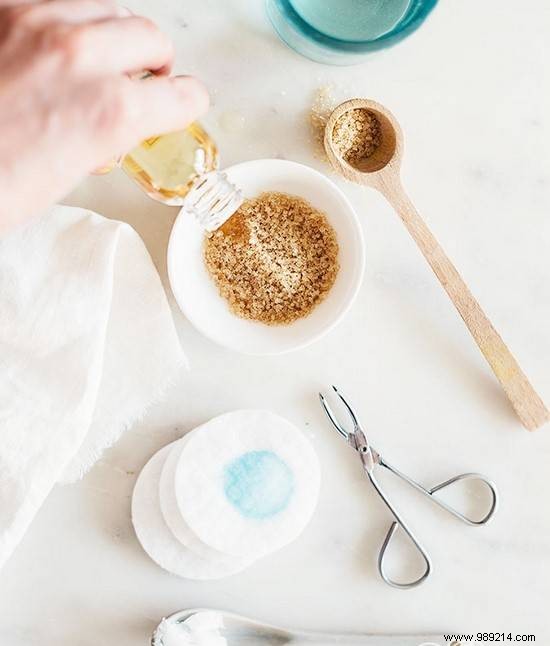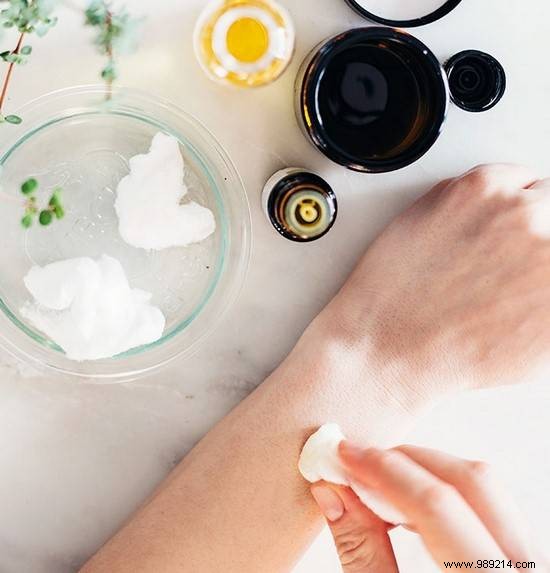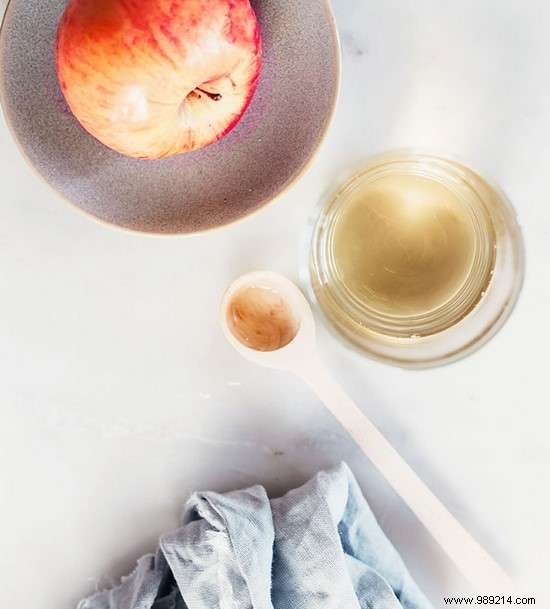
I'm sure this has happened to you after waxing.
You know those painful little red bumps that ruin the smoothness of your hair removal.
Besides, whether you did it with a razor or with wax, they still appear.
Normally, hair grows at the follicle. And they grow up and out of the skin.
An ingrown hair, as its name suggests, grows at an angle in the skin. Even worse, it rolls over and pushes down and grows into the skin.

Folliculitis is an infection of the hair follicle. It can be the consequence of ingrown hair. And it can possibly be accompanied by the formation of a pustule filled with pus.
Ingrown hairs are caused by waxing or shaving. This is very common with thick or curly hair.
That's why they're more common with pubic hair or beard hair...the 2 worst places you don't want to go through this!
As long as it is necessary to shave or wax, the miracle product against ingrown hairs will not exist....
So how do you get rid of ingrown hairs?
Rest assured, there are home remedies to avoid them, relieve the area and speed healing.
These remedies are effective and will allow you to treat ingrown hairs as long as you don't scratch them. Watch:

Let's be honest, there is a certain sense of relief and satisfaction when you wax.
But, when ingrown hairs decide to appear, it's immediately less nice...
It's ugly and it hurts, so much so that you want to get rid of it as soon as possible.
Know that there is a right and a wrong way to get the hair out of there.
If you do it the wrong way, you'll end up with a nasty infection that might last a long time.
The wrong way is to dig around the hair and squeeze it out with your fingernails.
Here is the right method to get the hair out easily and remove it:
- olive oil
- sugar (or a store-bought exfoliant)
- clean towels
- tweezers (preferably pointed)
- 70° alcohol
- Hot water
- coconut oil (optional)
- Prepare your equipment. Soak the tweezers in 70° alcohol, then rinse everything to sterilize them.
- You must first exfoliate the area to remove any dead skin cells that may be blocking the hair. This is important on women's legs in particular. You can use a gentle exfoliator like this.
But my favorite is simply mixing a little vegetable oil with sugar until you get a thick pasty texture. You don't need a lot of oil. Rub with a circular motion to dislodge all dead cells then rinse. It is an excellent homemade anti-ingrown hair scrub.
- Next, take a clean towel and run it under hot water. As hot as you can without it burning you, of course! Then, place it directly on the ingrown hair area for 10 minutes. You may need to run the towel under hot water a second time to keep it warm. This "softens" the hairs and opens the pores of the skin.
- Finally, use your sterilized tweezers and firmly grasp the bristles, as close to the skin as you can without irritating it. Give them a sharp blow to remove them. Rinse once more. And if you wish, apply a little coconut oil to soothe the skin and help it heal faster.
If the hairs don't come out, just put a hot towel on it for 10 min.
Do this twice a day until they appear. Some think it's the heat that helps the hair come out sooner, but it's mostly a way to keep it soft. It also minimizes irritation until it can be removed. Resist the temptation to pierce the skin and tweak it to get the hair out.
Also note that pointed tweezers are best.
Because they allow you to precisely grasp the hairs without pinching your skin. They are more effective in extracting a deep ingrown hair.

If removing hair one at a time isn't your thing, try exfoliating your skin with a baking soda paste. It is a natural treatment that helps to remove ingrown hairs.
You can of course use the sugar and olive oil scrub.
But it's not bad to have another recipe in your arsenal against ingrown hair.
Bicarbonate is quite sweet and inexpensive:we all have it in our cupboards. It helps to keep the follicle healthy while waiting for the ingrown hair to come out of the skin. In addition to this, bicarbonate helps relieve painful inflammation.
Apply a dab of coconut oil (or your favorite moisturizer) afterwards to keep skin soft.
As it is a gentle scrub, you can use it on the private parts (vulva, pubis...).
- baking soda
- fresh water
- coconut oil (or your moisturizer)
- Mix enough baking soda and water to form a fairly thick paste. It must be able to spread easily without forming lumps otherwise the paste may not stick to your skin.
- Wash your hands thoroughly with soap and water. Then apply the exfoliating baking paste with a firm but gentle circular motion.
- Rinse off residue with lukewarm water and apply coconut oil or moisturizer (just a little, no need to put a lot).

Tea tree essential oil is a wonderful essential oil for naturally healing something painful like an ingrown hair.
It has powerful antiseptic properties, can help ward off infection and shortens healing time. It also helps relieve discomfort and inflammation.
This natural solution also soothes itching. And it helps prevent big red pimples.
It's a grandmother's remedy that you can use after shaving your bikini line, for example.
You can choose this solution also if you have an ingrown hair on your chin.
Always be sure to dilute it before applying it to your skin to avoid irritation, burning or an adverse reaction.
- 2 tablespoons of olive oil (or another neutral oil)
- 15 drops of tea tree essential oil
- a dark glass bottle
- Cotton Swabs
- Mix neutral oil and tea tree essential oil. Wash the area where the ingrown hairs are.
- Using a cotton swab, dab a small amount of this mixture on the ingrown hair area. You don't have to put a lot.
- Repeat this operation twice a day. Keep the mixture in a closed glass bottle.
To discover: Tea Tree Essential Oil:14 Must-Know Uses.

Apple cider vinegar is an excellent remedy for ingrown hairs. Why ? Because it relieves the itching and discomfort associated with ingrown hair.
It is a natural remedy that cleans up ingrown hairs.
Depending on your skin type, applying apple cider vinegar directly to ingrown hair pimples can be a bit irritating. Give it a try on a small part, but it's worth a try, trust me.
Many people testify to the effectiveness of apple cider vinegar in treating inflammation of an ingrown hair.
When you know that inflammation accounts for half the pain of an ingrown hair, it's definitely worth a try.
Apple cider vinegar also helps prevent ingrown hair from becoming infected. If you prefer, you can also dilute it with hot water.
- cider vinegar (organic if possible)
To discover: 18 Apple Cider Vinegar Uses No One Knows About.

This trick may seem obvious, because I just mentioned it in 3 of the 4 remedies I just told you about.
Some people prefer not to use coconut oil as a full-body moisturizer. But that's just a matter of taste.
However, it is a good spot treatment for ingrown hairs. This provides a barrier between the blade and your skin when you shave. And it moisturizes the skin naturally to prevent itching and irritation afterwards.
- coconut oil
- Wash your hands and apply the coconut oil sparingly to the affected areas. Just a very thin layer will do.

The best thing to do is to avoid giving this type of hair a breeding ground. There is, unfortunately, no effective way to prevent them, but there are some tips and tricks that can help.
Hydrate: keep your skin well hydrated and supple. The hairs will be less blocked than under too hard skin. Indeed, it is the hard skin as well as the dead skin cells that force the hairs to grow to the side. It is an excellent preventive remedy to avoid razor burn and ingrown hairs.
This allows the razor to glide smoothly over the skin without drying it out. Say goodbye to itchy or stubborn curly hair. It is a kind of protective barrier during shaving, and it soothes the skin and prevents irritation afterwards.
Shave in the direction of hair growth: I can only insist on this point:shave in the direction of the hair. Yes, shaving against the hair gives a better result, but it's much more upsetting for your skin and your hair. When the blade passes over the hairs, it pulls them upwards.
Result:your hair is cut just below the surface of the skin. This is the best way for a hair to grow inside the skin. Shaving in the direction of the hair is just less friction and less irritation.
But above all it avoids pimples due to the razor and ingrown hairs. A good way to get rid of it naturally!
Exfoliate: use a little exfoliant before waxing. It will not be effective if the hairs are blocked under the skin. If you wax, it also makes it easier for the hair to grow back and especially outward from the skin.
Use single blades: they are less irritating than multi-blade razors. Even though the multiple blades give a good shaving result, the multiple pass has irritating effects, because the second and third blades have nothing to cut... so they scrape your skin.
Use new blades: if you use dull blades on the hairs, they will be cut poorly and have sharp edges (yes, hairs can have edges depending on hair types). Worse, worn blades can pull them out completely. All of this leads to ingrown hairs and pimples.